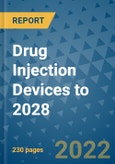The correlation between chronic conditions and the benefits of patient self-administration continues to influence therapeutic product decisions, managed care initiatives and regulatory actions. Drug injection device designs are increasingly being based on the results of human engineering inputs and patient preference research. Branding and packaging choices are more frequently being driven by data sources historically employed by consumer product marketers. For drug developers and device suppliers, the implications of these trends are influencing product development methodology and changing supply chain relationships. Decisions regarding as-supplied packaging that were once considered boilerplate have moved to the early stages of the development process.
Drug Injection Devices to 2028 - What You Will Learn
- What are the dynamics of the shifting landscape for injectable drug delivery and the market impact of new and evolving syringes and injectors by therapeutic indication?
- What are the market drivers influencing syringe and injector device designs, feature/functionality, product branding, competing technologies and commercial development?
- What are the key characteristics of the major injection device market segments and what is the impact of market demographics, and competing business strategies?
- What is the current market for syringe and injector demand by indication and therapy and what will it be in 2028?
- Who are the leading injection device companies, and what are their product development activities, business strategies, and corporate alliances and affiliations?
- What is the impact of economic, technology, and regulatory factors on injectable drug delivery demand?
Table of Contents
Executive Summary
The Market Opportunity
Competitive Landscape
Commercial Injection Device Classes - Strategic Analysis
Drug/Device Combination Products
Injection Device Selection Criteria
Drug Injection Device Market Segment Analysis & Forecasts
Injectable Drug Therapeutics - Market Factors
Samples

LOADING...








